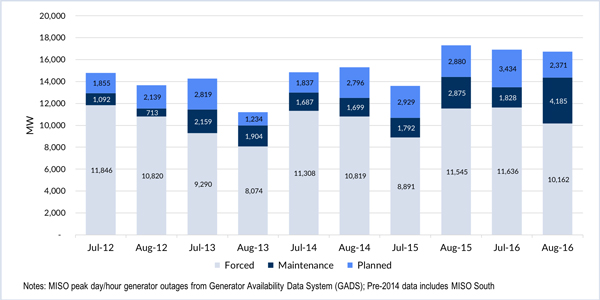By Amanda Durish Cook
CARMEL, Ind. — Facing an increased number of outages from an aging fleet of baseload generators across the footprint, MISO officials are examining how they can capture the risk of planned and maintenance outages occurring during peak load.
Ryan Westphal, MISO resource adequacy coordinator, said an investigation by the RTO’s Loss of Load Expectation Working Group suggests a need to account for intentional outages, but stakeholders have not yet reached consensus on how to proceed.
“Every year [since 2012], we saw some number of both planned and maintenance outages that happen on peak,” Westphal said during a Nov. 8 Resource Adequacy Subcommittee meeting.
Westphal said MISO has looked into incorporating a combined average volume of planned and maintenance outages into its loss-of-load-expectation (LOLE) calculation, which would bump up the RTO’s predicted 17.1% planning reserve margin by about 0.4% in the 2018/19 planning year. The increase would lead to an additional 600 MW being cleared in this year’s capacity auction, MISO estimated.
MISO currently does not model any planned and maintenance outages at peak load, assuming such outages are optimized and not occurring during peak demand, but the RTO may want to revise its LOLE study to include the probability that some outages will occur during the peak, Westphal said.
“It leads us to think that all the risk isn’t being captured in our planning reserve margin today,” he said. Over the last several years, MISO has carried a sufficient reserve margin to cover outages that occur on peak, he added.
During July 2016, MISO experienced about 3.4 GW of planned outages and 1.8 GW of maintenance outages. The following month saw planned and forced outages of 2.4 GW and 4.2 GW, respectively. While those outages combined were nowhere near the volume of forced outages in the summer (12 GW in July, 10 GW in August), they helped nudge total outages above 16 GW during both months, a benchmark that was surpassed only once before in August 2015.
Duke Energy’s Brian Garnett asked how a maintenance outage occurs that’s not already planned or forced.
MISO defines maintenance outages as less severe mechanical issues that don’t result in an immediate outage trip but must be scheduled for repairs, Westphal said.
Indianapolis Power and Light’s Ted Leffler asked if the new calculation will be applied universally across the footprint or target individual units.
“I would caution that not every generation unit that has planned outages has load,” Leffler said.
Westphal said MISO would discuss the proposal again next month, and asked stakeholders to send written feedback before the Thanksgiving holiday.





